
A draft horse (US), draught horse (UK) or dray horse, less often called a carthorse, work horse or heavy horse, is a large horse bred to be a working animal doing hard tasks such as plowing and other farm labor. There are a number of breeds, with varying characteristics, but all share common traits of strength, patience, and a docile temperament which made them indispensable to generations of pre-industrial farmers.

The Friesian is a horse breed originating in Friesland, in the Netherlands. Although the conformation of the breed resembles that of a light draught horse, Friesians are graceful and nimble for their size. It is believed that during the Middle Ages, ancestors of Friesian horses were in great demand as war horses throughout continental Europe. Through the Early Middle Ages and High Middle Ages, their size enabled them to carry a knight in armour. In the Late Middle Ages, heavier, draught type animals were needed. Though the breed nearly became extinct on more than one occasion, the modern day Friesian horse is growing in numbers and popularity, used both in harness and under saddle. Most recently, the breed is being introduced to the field of dressage.
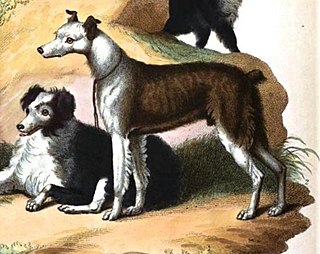
A cur was a now-extinct dog breed used by cattle drovers in England. In the United States a short-haired dog used in hunting and herding is called "cur-tailed", or "cur" for short.

The Clydesdale is a Scottish breed of draught horse. It is named for its area of origin, the Clydesdale or valley of the River Clyde, much of which is within the county of Lanarkshire.
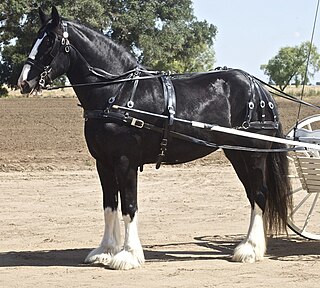
The Shire is a British breed of draught horse. It is usually black, bay, or grey. It is a tall breed, and Shires have at various times held world records both for the largest horse and for the tallest horse. The Shire has a great capacity for weight-pulling; it was used for farm work, to tow barges at a time when the canal system was the principal means of goods transport, and as a cart-horse for road transport. One traditional use was for pulling brewer's drays for delivery of beer, and some are still used in this way; others are used for forestry, for riding and for commercial promotion.
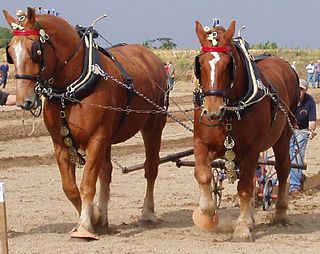
The Suffolk Horse, also historically known as the Suffolk Punch or Suffolk Sorrel, is an English breed of draught horse. The first part of the name is from the county of Suffolk in East Anglia, and the word "Punch" is an old English word for a short stout person. It is a heavy draught horse which is always chestnut in colour, traditionally spelled "chesnut". Suffolk Punches are known as good doers, and tend to have energetic gaits.
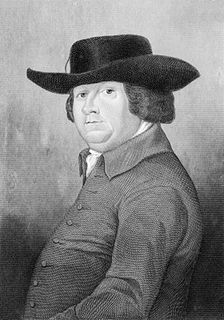
Robert Bakewell was an English agriculturalist, now recognized as one of the most important figures in the British Agricultural Revolution. In addition to work in agronomy, Bakewell is particularly notable as the first to implement systematic selective breeding of livestock. His advancements not only led to specific improvements in sheep, cattle and horses, but contributed to general knowledge of artificial selection.

The Gypsy Cob, also known as the Traditional Gypsy Cob, Irish Cob, Gypsy Horse, Gypsy Vanner, or Tinker Horse is a type or breed of domestic horse from the islands Great Britain and Ireland. It is a small, solidly-built horse of cob conformation and is often, but not always, piebald or skewbald; it is particularly associated with Irish Travellers and English Romanichal Travellers of Ireland and Great Britain. There was no stud-book or breed registry for horses of this type until 1996, but as breeders developed standards and recorded pedigrees, there are now organizations that register qualifying horses..

The Canadian horse is a horse breed from Canada. It is a strong, well-muscled breed of horse, usually dark in colour. The horses are generally used for riding and driving. Descended from draft and light riding horses imported to Canada in the late 1600s, it was later crossed with other British and American breeds. During the 18th century the Canadian horse spread throughout the northeastern US, where it contributed to the development of several horse breeds. During the peak popularity of the breed, three subtypes could be distinguished, a draft horse type, a trotting type and a pacing type. Thousands of horses were exported in the 19th century, many of whom were subsequently killed while acting as cavalry horses in the American Civil War. These exports decreased the purebred Canadian population almost to the point of extinction, prompting the formation of a studbook and the passage of a law against further export.

The Dales pony is one of the United Kingdom's native mountain and moorland pony breeds. The breed is known for its strength, hardiness, stamina, courage, intelligence, and good disposition. The history of the modern Dales pony is strongly linked to the history of lead mining in the Dales area of Yorkshire, and it was originally a working pony descended from a number of breeds. A breed registry was created in 1916, and the breed was used extensively by the British Army in both world wars. The Dales pony almost became extinct during the Second World War, but post-war conservation efforts have had some success in rebuilding the population. Today it is used for many different activities, but population numbers are still low and this has led to it being considered "critical" by the Rare Breeds Survival Trust and "threatened" by The Livestock Conservancy.
Juliet Clutton-Brock, FSA, FZS was an English zooarchaeologist and curator, specialising in domesticated mammals. From 1969 to 1993, she worked at the Natural History Museum. Between 1999 and 2006, she was the managing editor of the Journal of Zoology.

Sabino describes a distinct pattern of white spotting in horses. In general, Sabino patterning is visually recognized by roaning or irregular edges of white markings, belly spots, white extending past the eyes or onto the chin, white above the knees or hocks, and "splash" or "lacy" marks anywhere on the body. Some sabinos have patches of roan patterning on part of the body, especially the barrel and flanks. Some sabinos may have a dark leg or two, but many have four white legs. Sabino patterns may range from slightly bold face or leg white markings—as little as white on the chin or lower lip—to horses that are fully white.
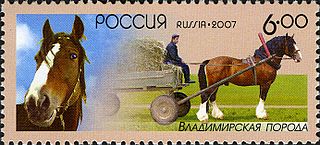
The Vladimir Heavy Draft is a Russian breed of heavy draught horse. It was bred in the early twentieth century in farms and collectives in Ivanovo Oblast and Vladimir Oblast, to the east of Moscow. The most important influence on the development of the breed was from three Clydesdale stallions foaled between 1910 and 1923. The Vladimir was officially recognised in 1946.

The Wessex Saddleback or Wessex Pig is a breed of domestic pig originating in the West Country of England, (Wessex), especially in Wiltshire and the New Forest area of Hampshire. It is black, with white forequarters. In Britain it was amalgamated with the Essex pig to form the British Saddleback, and it is extinct as a separate breed in Britain. However, the Wessex Saddleback survives in Australia and New Zealand.

The Australian Draught is a hardy Australian breed of draught horse, noted for its strength and a good temperament.

The Scottish Dunface, Old Scottish Short-wool, Scottish Whiteface or Scottish Tanface was a type of sheep from Scotland. It was one of the Northern European short-tailed sheep group, and it was probably similar to the sheep kept throughout the British Isles in the Iron Age. By the mid-nineteenth century it had mostly been displaced by the Scottish Blackface and it became extinct on the mainland of Scotland in the late nineteenth century. However, several local types of Dunface survived on islands around Scotland, giving rise to or contributing to existing breeds including the Shetland, North Ronaldsay, Hebridean and Boreray.

The known history of the horse in Britain starts with horse remains found in Pakefield, Suffolk, dating from 700,000 BC, and in Boxgrove, West Sussex, dating from 500,000 BC. Early humans were active hunters of horses, and finds from the Ice Age have been recovered from many sites. At that time, land which now forms the British Isles was part of a peninsula attached to continental Europe by a low-lying area now known as "Doggerland", and land animals could migrate freely between what is now island Britain and continental Europe. The domestication of horses, and their use to pull vehicles, had begun in Britain by 2500 BC; by the time of the Roman conquest of Britain, British tribes could assemble armies which included thousands of chariots.

The Norman Cob or Cob Normand is a breed of light draught horse that originated in the region of Normandy in northern France. It is of medium size, with a range of heights and weights, due to selective breeding for a wide range of uses. Its conformation is similar to a robust Thoroughbred, and it more closely resembles a Thoroughbred cross than other French draught breeds. The breed is known for its lively, long-striding trot. Common colours include chestnut, bay and seal brown. There are three general subsets within the breed: horses used under saddle, those used in harness, and those destined for meat production. It is popular for recreational and competitive driving, representing France internationally in the latter, and is also used for several riding disciplines.
The Blue Albion was a British breed of cattle with an unusual blue roan coat. It originated in the English Midlands in the late nineteenth or early twentieth century, and was a dual-purpose breed, reared both for beef and for milk. It became extinct following the foot-and-mouth outbreak of 1967.

The Staghound, sometimes referred to as the English Staghound, is an extinct breed of scent hound from England. A pack hound, the breed was used to hunt red deer and became extinct in the 19th century when the last pack was sold.



















